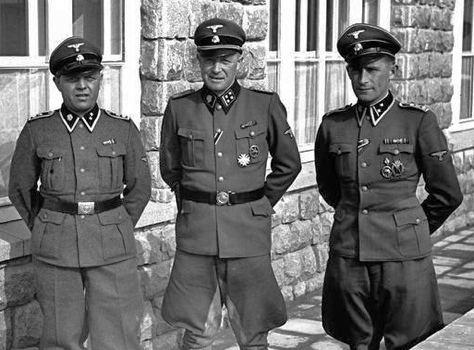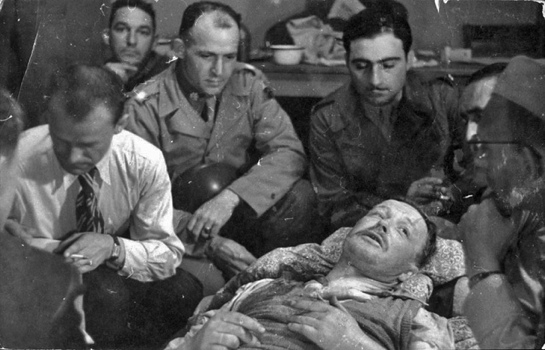History's Judgement: SS-Standartenfürhrer Franz Ziereis, Kommandant of the KL Mauthausen-Gusen


Above left: Kommandant SS-Obersturmbannführer Franz Ziereis with SS-Hauptscharführer (Master Sergeant) and SS-Oberscharührer (Technical Sergeant) at Mauthausen (91,047 bytes).
At right: being interrogated by US Army officers on 23 May 1945 at the 131st Evac Hospital in Gusen, there dying of gunshot wounds (78,773 bytes).
Click on images to see enlarged view (163,967 and 174,749 bytes).
 Franz Xaver Ziereis was born on 13 August 1905 in Munich. After attending a commercial college in Munich on 1 April 1924 Ziereis enlisted in the Reichswehr, Germany's post World War Army. He served in the 19 Bayerische Regiment, then after twelve years he was discharged with the rank of Feldwebel (Sergeant).
Franz Xaver Ziereis was born on 13 August 1905 in Munich. After attending a commercial college in Munich on 1 April 1924 Ziereis enlisted in the Reichswehr, Germany's post World War Army. He served in the 19 Bayerische Regiment, then after twelve years he was discharged with the rank of Feldwebel (Sergeant).
On 30 September 1936 Ziereis joined the SS as their 276,998th member, and was awarded the rank of SS-Obersturmführer (First Lieutenant) on 1 October 1936. In 1937 he was given command of the 22nd Hundertschaft (hundred man unit) of the SS Totenkopf (Death's Head) detachment, 2nd Standarten (regiment) “Brandenburg”, consisting of concentration camp guard personnel. On 12 September 1937 he was promoted to SS-Hauptsturmführer (Captain). The 22nd Hundertschaft was among the SS units assigned to support the Anschluss, when Austria was annexed to the German Third Reich and occupied on 12 March 1938. On 1 July 1938 he transferred to the SS Totekopf 3rd Standarten "Thüringen" as a training instructor where he was initially assigned to the Buchenwald prison camp, and there on 25 August 1939 he was promoted to SS-Sturmbannführer.
Right: SS-Standartenführer Franz Ziereis shown wearing his Deutsche Kreuz awarded in the fall of 1944 for distinguished service (45,617 bytes).
There is some mention that Ziereis was somehow injured while with the 3rd Standarten Thüringen. But regardless of that Theodor Eicke, the Inspector of Concentration Camps, had already come to know of Ziereis. Eicke appreciated his military capabilities and leadership qualities so he assigned Ziereis to replace Albert Saur as commandant of the new Mauthausen-Gusen prison camps on 9 February 1939. By 8 May 1939 the facilities were designated "Konzentrationslager" (Concentration camp), hence commonly referred to as “KL Mauthausen-Gusen”. On 25 August 1939 Ziereis was promoted to the rank of SS-Sturmbannführer (SS Major), and soon after construction of the second camp Gusen commenced.
By June of 1940 KL Mauthausen-Gusen had expanded to include not only larger main camps, but numerous satelite camps that were similarly under the command of Ziereis. In January 1941 the two mains camps of KL Mauthausen-Gusen were designated Grade III facilities, the only two in the Nazi system intended to house "Incorrigible Political Enemies of the Reich" who were often classified "Rûckkehr unerwünscht" (return not desired). On 1 September 1941 Ziereis was promoted to SS-Obersturmbannführer (Lt. Colonel).
Soon after then on 20 April 1944 Ziereis was promoted to SS-Standartenführer (SS Colonel) for "outstanding service as camp commandant". The Mauthausen-Gusen complex continued to expand, in large part to meet the needs of wartime production, so much so that by April 1945 the complex included 101 camps including 49 major Außenlager (external or sub-camps). All of these were answerable to Ziereis.
On 10 April 1945 Ziereis was among a dozen officers called to a meeting at Linz Donau with SS-Obergruppenführer Kaltenbrunner, apparently their last face to face meeting.
With the US Army closing in from the West, and the Soviet Army from the East, on the morning of 3 May 1945 Ziereis departed KL Mauthausen with his wife and three children driving to his mountainside hunting lodge near Spital am Pyhrn in Upper Austria. On 23 May 1945, after his wife had driven away on an errand, Ziereis was observed near the lodge. His identity was confirmed by former Polish inmates accompanying the US soldiers. The arrest attempt turned into a brief foot chase, and while trying to escape the Americans Ziereis was shot at and wounded at about 18:00 hrs (6 pm). His handgun was recovered near where he fell. Ziereis was shot once through the upper left arm, and as he spun round he suffered a mortal gunshot wound in the back passing through a lung and through his stomach, exiting the other side*.
-
*Some accounts, in error, mention Ziereis was shot three times but even by his own deathbed statement he was struck by gunshots twice.
Ziereis was arrested, given first aid, then transported to the US Army 131st Evac Hospital in Gusen, arriving there at 21:30 Hrs (9:30 pm). There Ziereis was questioned over six to eight hours that night with Colonel Richard R. Seibel of the 11th Armored Division then commanding Mauthausen, other US Army personnel and civilians. His statement explaining camp operations and his role too was taken and the multipage document translated ; both survive in United States Archives. He was one of about 2,893 patients being cared for there, but he died of his wounds at 07:30 Hrs (7:30 am) on 24 May.
-
There are some history revisionists, the kind that base their facts on beliefs such as: the Earth is flat, there were no concentration camps, that there are such things as alternative facts, etc.. Actual reality could shatter their paltry egos, so they claim Ziereis made no statement and was dead when the several photos of him speaking with his captors were taken, or that he never was taken to a hospital; but these theories simply defy facts, logic and reason. The facts are corroborated not only by several photos taken of Ziereis at the hospital, as above showing several US Army personnel and officers alongside Ziereis, but also by numerous documents including the official log book of the US Army 131st Evac Hospital now in custody of the US National Archives.
Ziereis's body was moved to the morgue of the hospital however, soon afterwards Polish and Russian former inmates of the camp removed Ziereis's body. Soon afterwards his body was observed (and photographed) hanged by the neck from a concrete fence post, and with his legs straddling the barbed wire fence at Mauthausen. He was completely naked except for the bandage on his left arm, and with his torso and buttocks painted with red anti-Nazi graffiti “Heil Hitler”. and swastikas. A photo taken of Ziereis's body on the wire shows his posterior and hands with signs of Livor mortis, postmortem lividity, indicating that after death the body had been in a supine position long enough for his blood to pool there. This desecrating of a dead body is certainly against US military regulations, but was done by understandably aggrieved former prisoners and recorded in the above referenced hospital log entries. But after what the American soldiers who had liberated these camps had experienced, they probably felt no need to interfere with the prisoners. There on the fence Ziereis remained for several days until the stench of decay prompted an US Army officer to order the body removed and buried anonymously.